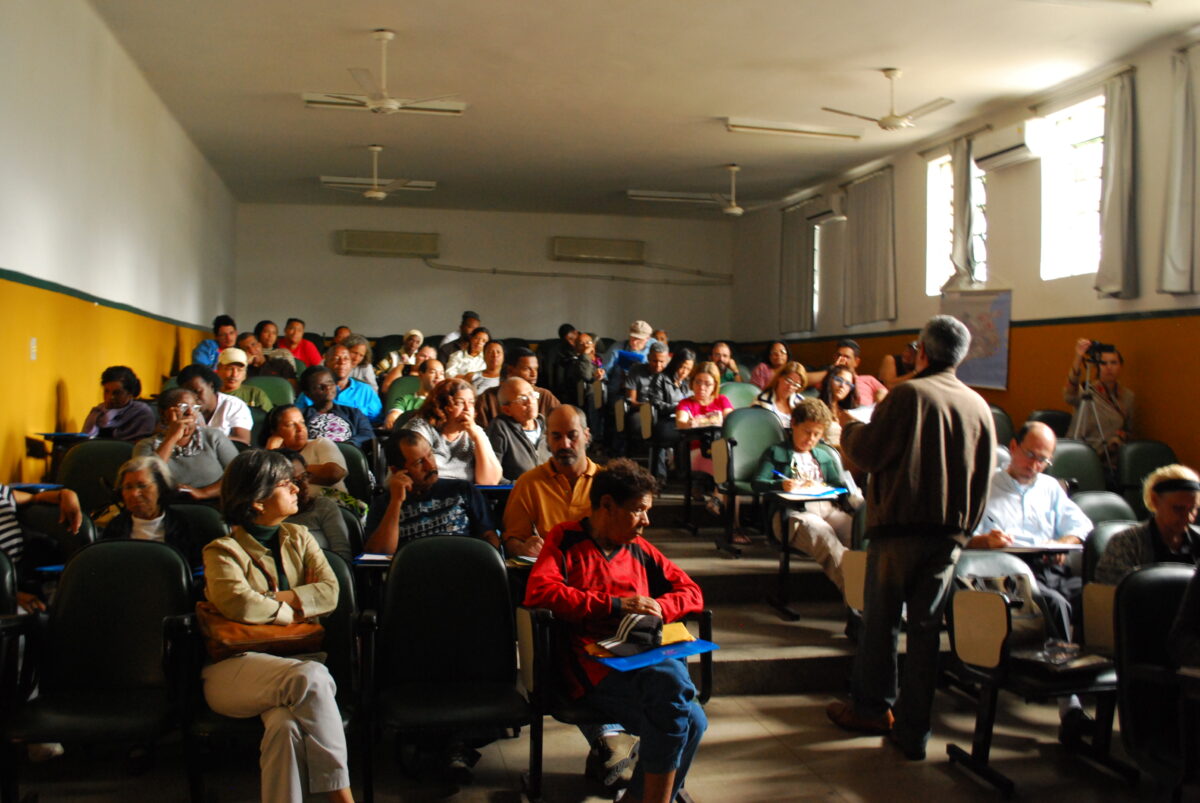
On Saturday October 22nd at the Colégio Estadual Brigadeiro Schorcht, A Fundação Centro da Defesa de Dirietos Humanos Bento Rubião (henceforth Bento Rubião) held the last of five workshops that focused on their proposal for the Municipal Plan of Social Housing (PMHIS) in Rio de Janeiro. Bento Rubião objective was to create a space where residents from different areas of Rio de Janeiro could have the opportunity to voice their concerns and engage in a dialogue with various representatives from the Municipal Housing Secretary (SMH) and the Ministry of urbanism.
The workshops were the culmination of what started out as a course that focused on residents’ rights to the city and their right to housing. On the folder advertising the workshops Bento Rubião described the PMHIS as “a basic and necessary requisite for uniting with the National System for Social Housing (SNHIS) as well as increasing access to the National Fund for Social Housing (SNHIS). It should contain strategies and actions for the next 15 years, aimed at promoting ‘the right to housing’ and ‘the right to the city’.” After the course had ended, participants were invited to attend workshops that were located in their respective residential areas of Rio de Janeiro. In order to employ a more local approach to the issues Rio de Janeiro was divided into five Planning Areas (APs). AP 1 included the south and north zones (neighborhoods such as Santa Teresa, Ilha do Paquetá, Centro and Portuária ), AP 2 dealt with the south zone (neighborhoods such as Botafogo, Tijuca, Copacabana, and Rocinha, AP 3 encompassed the farther limits of the north zone (neighborhoods such as Penha, Ramos, and Vigário Geral). AP 4 covered the southern part of the west zone (neighborhoods such as Cidade de Deus, Barra da Tijuca, and Jacarepaguá), and AP 5 was comprised of the northern part of the west zone (neighborhoods such as Bangu, Campo Grande, and Santa Cruz).
Those who finished the course, as well as any interested residents of the respective areas, were invited to participate in their local workshops. Each workshop was conducted according to the interests of the local planning areas. The schedule was organized around presentations and discussions, providing residents with an opportunity to learn about projects occurring at the level of municipal urban planning and giving policy makers and planners the opportunity to hear the wants and concerns of residents. For example, the workshop for AP 1 featured a presentation about the Rio’s waterfront zone, which is located in the city center, because it is a highly valuable area and the subject of interest for residents of that specific planning area.
Throughout the five workshops numerous interesting conversations took place and many concerns were voiced. Popular themes included transportation, the presence (or lack thereof) of city services, and abandoned buildings and lots. Although the conversations were fascinating and the workshops as a whole were useful in allowing residents of Rio to have greater say in the way their city is advancing towards the future, the workshops were not without their problems. Turn out varied for each workshop, but it tended to be sparse, especially when comparing the number of attendees to the populations of their planning areas. In the folder that was distributed at each workshop, Bento Rubião wrote a small blurb about the need for a participatory process: “the participation of society is fundamental so that the PMHIS implementation process can be democratic and inclusive.” Participation could have been low for a number of reasons; including, transportation costs, having no one to watch children, and the need to work while the workshops were taking place are all likely reasons for the low attendance. The most probable reason, however, for the relatively small number of people at the workshops was lack of information and interest. This is a concern that is certainly not unique to Bento Rubião. These are much bigger issues that are common to many societies and social classes. It is always a challenge to inform a large number of people about an important event, and this is particularly true in poorer areas where social networks may not be as strong and where the relay of information is usually more problematic. It is also difficult to motivate and convince people that their presence really matters. In most poor communities of Brazil this is especially difficult because many live in the margins of society, literally and metaphorically, and feel ignored by the powers that be. Convincing low income Brazilians that they can actually play an important role in the development of their city is complex and can result in passivity and low participation rates at important events. This is notion is often called social capital and there is a copious amount of research in the academic and policy literature on the dynamics of social capital in poor Brazilian communities.
Other challenges that were present at the workshops included the noticeable divide between the representatives from the various government agencies; such, as the SMH and Ministry of Urbanism, and low income residents from the planning areas. The two groups approached the workshops from significantly different angles, one from a more academic, policy-making stance and the other from the more lived experience side. On Saturday the 22nd at the last workshop, a female resident of one of the planning areas represented to a great extent the divisions between the two sides. She spoke of her inability to relate to the word ‘methodology,’ which was the main subject of the first presentation and was used to describe the process Bento Rubião intends to employ in regards to the PMHIS. Her statement was powerful because it challenged not only Bento Rubião’s plans, but also larger concepts of urban accessibility and inclusion. As she expressed her inability to understand and relate to the way in which the plan was being presented, she illuminated the fact that a large portion of the population – especially the poorer population – is often left out of important citywide decision making and other processes. Another problem, which relates to the gap between professionals and low income residents, was the hot topic issue residents raised concerning the forced evictions occurring in many favelas as Rio prepares for the World Cup and Olympics; which unfortunately comes as no surprise. It seemed that many of the residents attended the workshops to discuss this issue, but regrettably the workshops did not seem structured to address the forced evictions as much as the attendees desired. Apparently some attendees left the workshops feeling that the problems that most directly affect their lives were not discussed.
An additional statement that powerfully touched upon the rift between theory and practice was made by another woman in attendance. She suggested that the best way to proceed would be to marry the academic/policy-making stance with the lived experience side. It seems like the most appropriate way to move forward. Bento Rubião plans to conduct the course again next year and also intends to conduct thematic seminars that will continue the conversation about residents’ rights within the city. Although problems arose at the workshops this is normal in any participatory planning initiative. What Bento Rubião is attempting to do in Rio is unprecedented. The participatory space that they are creating is necessary for the well-being of the city of Rio de Janeiro and its residents.


You must be logged in to post a comment.